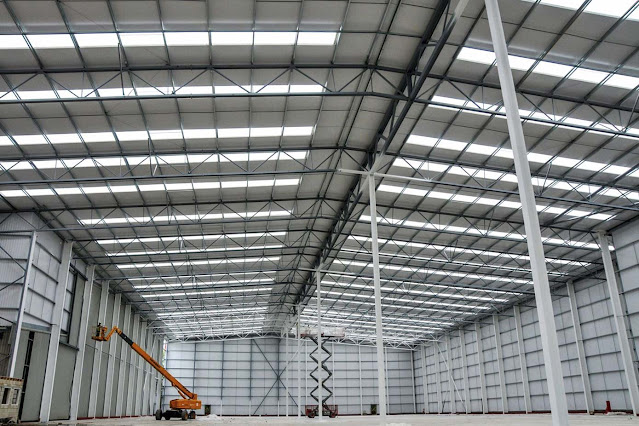There are a wide variety of roofing materials which you should not only consider the look but also their service life, cost, longevity, availability, durability, energy efficiency, and must be low-maintenance.
>> Related Post: Types of Quality Roofing Services.
Choosing the right roofing materials will save you much in the long run because it will cost you less with the repair, restoration, or replacement.
These are the common roofing materials that are widely used in the industrial roofing system:
1. TPO (Thermoplastic Polyolefin)
Thermoplastic Polyolefin is a single-ply membrane that is known to be durable, long-lasting, and energy-efficient as it has the ability to resist both heat and UV rays which helps greatly with the indoor air system.
TPO is manufactured by sheets that come in different sizes and are available in different colors.
Thermoplastic Polyolefins (TPOs) are polypropylene based materials that have been modified to provide better ductility and impact resistance compared to standard off-the-shelf Polypropylene (PP) grades.
TPOs retain the ease of processing, lightweight nature, and chemical resistance of PP. However, they do not require drying prior to molding, which saves on both cost and time.
>> Related Post: Introducing CRM roofing: The ultimate solution for roofing durability.
Often, TPOs are compounded with fillers – usually minerals – to provide a good balance of stiffness and impact resistance, as well as better dimensional stability and increased Heat Deflection Temperature (HDT).
Proper choice of minerals allows these filled compounds to retain ductile behavior well below 0 °C, something traditional PPs cannot achieve. Stiffness and impact resistance can be custom tailored to provide the right balance for a wide range of applications.
While the cost of TPOs are often slightly higher than traditional PP compounds, TPOs are still a very cost effective choice for applications requiring good impact resistance and stiffness when other Polyethylene (PE) or PP materials do not meet the application demands.
TPO compounds can be formulated for increased UV weathering and scratch/mar resistance when needed.
The UV grades of RTP Company’s TPO compounds were designed to be compatible with common paint systems to provide an all-in-one solution for situations where some parts are painted and some are not.
2. Built-Up Roofing
Built-Up Roofing System is the oldest flat roofing system. This type of flat roof is made from layers of asphalt and bitumen and combined with roofing felts.
The process of the built-up roofing system is the application of hot tar or asphalt blended with bitumen which is being reinforced with roof felts.
Built-up roofs are one of the top choices for flat and low-sloped buildings. The insulation sheets increase a home or building’s energy efficiency, while the aggregate at the top of the roof is fire resistant.
The alternating layers provide a tight seal that protects against water leaks.
The average built-up roof will last from 15-30 years, but if well maintained and in an area with a mild climate, it can last for up to 40 years.
Factors that decrease the time a BUR will last include cold and snowy climates, air conditioning units that sit on top of the roof, and pooling water.
>> Related Post: Swadley Roof System is the best roofing company.
To maintain a BUR roof and increase longevity, ensure proper drainage and deal with pooling water as quickly as possible.
You should inspect a BUR at least twice yearly to look for cracks, pooling, blistering, split joints, and other signs of damage.
3. Metal Roofing
Metal Roofs are commonly made of stainless steel, aluminum, zinc, copper, and aluminum. This roof comes in different sizes by their gauge.
Metal roofs are best known for their long lifespan, energy efficiency, lightweight, easy installation, and low maintenance.
A metal roof is a roofing system featuring metal pieces or tiles exibiting corrosion resistance, impermeability to water, and long life.
It is a component of the building envelope. The metal pieces may be a covering on a structural, non-waterproof roof, or they could be self-supporting sheets.
Metal roofs are 100% recyclable and can be made from other recycled products.
Asphalt shingles are petroleum based with other chemicals making their recycling process more toxic, most shingles are not recycled and 20 billion pounds are sent to landfills every year and take hundreds of years to decompose.
>> Related Post: Ideas to Promote Your Roofing Company.
Metal roofs emissivity is better at reflecting solar radiation at 10%-75% depending on the color choice, compared to asphalt roofs that reflect 5%-25% depending on their color.
Over the lifetime of the metal roof they keep 95% of the reflective capacity compared to other roof types that loose 20%-40% of their reflective capacity.
The highly reflective coatings in the paint of metal roofing can lower utility bills by 40%.
Conclusion
Swadley Roof Systems offers the best roofing services in the Houston, Austin, San Antonio and Dallas area.
- Tel: 832-559-8463
- Email: info@swadleyroofsystems.com
- Location: 17413 FM 2920 Suite O Tomball, TX 77377
- Facebook: Fanpage Swadley Roof Systems
- Website: https://www.swadleyroofsystems.com/







0 Comments
Đăng nhận xét